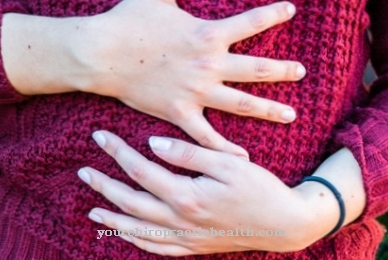A proliferation - For many people the term does not bode well. Almost everyone has a growth somewhere in the body and not every growth is also a malignant tumor. But how do you recognize a growth?
What is a growth?

Under one proliferation we mean tissue that deviates from the normal state. Other common terms are lump, tumor, and swelling.
There is also talk of "wild meat" among medical professionals. Growths are thickened tissue that has grown suddenly and very quickly. They can occur virtually anywhere in the human body. This also includes cysts on the ovaries, as well as growths in adipose tissue or polyps in the throat.
Ingrown skin on nails is also known as growth, but is harmless. Due to their nature, growths are divided into different classes. Typical forms of growths are polyps, cysts, abscesses and benign and malignant tumors.
causes
The causes for Growths are not known in every case. The place where the growth first appeared is also important. In the beginning, however, there is always an uncontrolled growth of cells.
This growth is misdirected. Growths can arise due to external influences. This can already include a strong blow. Pressure points (for example on the foot) can also lead to increased skin growth. Growths can also grow on the gums after surgery.
The genetic background must not be forgotten either. Growths can also be the result of ingesting chemical substances. Organs that are always inflamed in a certain place also tend to develop growths.
Diseases with this symptom
- tumor
- Intestinal polyps
- Gastric polyps
- Liver cyst
- Polyps
- Gallbladder polyps
- Anxiety disorder
- Breast cysts
- Ovarian cyst
- Fibroma
- Nasal polyps
- Jaw cysts
Diagnosis & course
The emergence of a proliferation almost always goes unnoticed. Only when the growth has reached a certain extent does the person concerned become aware.
Organs can be pushed aside, which leads to painful complaints. Nerves are pinched off or the blood supply is blocked. In other cases, the growths become easily visible and can be easily felt over the skin. This does not have to be seen as a bad sign.
The diagnosis of an overgrowth is made by the doctor in all cases. He can best tell what shape it is. In addition to visual devices, he also uses other methods such as laboratory tests and biopsies. Only then is the diagnosis of growth established.
Complications
In the case of a growth, there is initially the risk that it is an ulcer or a malignant tumor. Depending on the extent and location of the tissue proliferation, movement disorders and pain can arise, which increase as the growth grows. The growth itself can lead to circulatory disorders, feelings of pressure and pain.
If the growth increases in size, there is also the risk that other tissue, nerves and organs will be displaced. A larger growth in the gastrointestinal tract can cause constipation, in the heart area it can rarely lead to life-threatening cardiac arrhythmias. Typical complications are pressure on the nerves and the surrounding blood-carrying tissue and the impairments that go with it.
If the growth bursts open, pus and blood enter the body, which can lead to life-threatening infections. If the tissue proliferation is based on a serious illness, this can lead to further complications. Most complications can be reliably dealt with by removing the growth; In some cases, however, the wound becomes inflamed, which can lead to the formation of further cysts and infections, but also to the formation of scars.
When should you go to the doctor?
Whether a growth needs to be treated depends on the type and size of the tumor and possible accompanying symptoms. Fibromas and warts, for example, are cosmetic blemishes and do not necessarily require treatment. A doctor's visit is only necessary if the growth becomes a mental burden, as is the case above all with fibroids in the face, neck or genital area.
Larger growths should always be removed in order to minimize the risk of injury. In addition, all growths should be clarified and, if necessary, treated that occur for no apparent reason and that are associated with accompanying symptoms such as itching, bleeding or fever. If atheroma or an ulcer is suspected, a doctor should be consulted for diagnostic purposes only.
This is especially true for children, the elderly, pregnant women and patients with pre-existing skin or internal organs. In the case of blood sponges and similar tumors, you should speak to your family doctor or pediatrician immediately. Suitable contact persons are also the dermatologist, specialists in dermatology and doctors in internal medicine.
Doctors & therapists in your area
Treatment & Therapy
Treating a proliferation depends on their nature and position in the body. First of all, it has to be determined what type of growth it is.
Harmlessly ingrown flesh on the toenail is of course treated in a different way than a malignant tumor in the breast. In severe cases in particular, treatment ranges from the administration of medication to chemotherapy and radiation therapy to surgery. This removes the growth. This can be done under general anesthesia or under local anesthesia.
The removal of nasal polyps is known. It usually takes place in early childhood and lastingly improves free breathing. Immunosuppressants can also be used for a growth. The reason: Growths arise in an (over) active organism. Immunosuppressants can reduce this activity a little. Many sufferers also seek help in alternative healing methods when they have a growth. Good experiences have been made with acupuncture (including laser acupuncture) and the bioresonance method.
Nevertheless, you should not experiment with a growth. Under no circumstances should you "snip" around harmless-looking wild meat with scissors. Growths belong in the hands of a doctor. Otherwise it is easy for a simple skin change to develop into serious inflammation.
Outlook & forecast
As a rule, the further course of a growth strongly depends on the affected region. In severe cases, the growth occurs on the internal organs. The overgrowth changes or completely reduces the functions of the affected areas. This can also lead to pain or a complete loss of function of the organs. In some cases, nerves are pinched by the growth, which can lead to paralysis or impaired sensitivity.
If the function of internal organs is damaged, this can in the worst case also lead to death. Often the patient's everyday life is restricted by the disease and the quality of life decreases sharply. There are also aesthetic complaints if the growth is directly visible on the skin. As a result, the patients sometimes suffer from depression and decreased self-esteem.
In most cases, an overgrowth is removed surgically or with the help of radiation. Whether or not there are complications depends to a large extent on the extent of the growth.
prevention
It is not always possible to stand in front of one proliferation to protect. However, a healthy lifestyle should be in the foreground in order to strengthen the immune system. This also includes avoiding alcohol and cigarettes as much as possible. Both substances have a cell-damaging effect. Nevertheless: There is no guarantee that there will be no growth.
You can do that yourself
Growths can have various causes and are mostly harmless. With typical growths such as warts, age spots and Co., simple measures and remedies from the household and homeopathy help.
Pedunculate warts, such as those found under the armpits or on the neck, are best removed with table salt or propolis. Applications made from banana and yogurt, which are applied to the soft fibroids overnight, also help. Blackheads can be dealt with with warm steam and lotions made from apple cider vinegar or coconut oil. Lemon juice and rest help against age spots. The skin and especially the growth should be protected from excessive sunlight and treated with care products from specialist shops. With growths in the form of herpes, zinc and toothpaste from the household help. One effective natural remedy is tea tree oil, which is best applied directly to the sore blisters.
Larger growths that are painful or have accompanying symptoms should be treated by a doctor. It may be a malignant growth that, if treated incorrectly, can become inflamed and spread further.
























.jpg)



